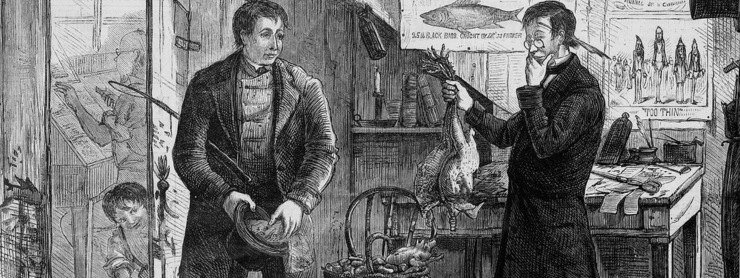For two summers in a row, squash bugs and vine borers have decimated my zucchini. This year I tried to delay the inevitable. I grew my squash from heirloom seeds, lovingly planted in fertilized mounds surrounded by dill, nasturtium and other plants that attract wasps known to prey on squash-loving insects. I watered them daily and watched with eager anticipation as the vines flourished and bees darted in and out of each sun-yellow blossom. But in the end, it didn’t matter. My soil still harbored the infestation from the previous year. By late June, the squash bugs began rutting and laying triangles of copper-colored eggs on the undersides of leaves while vine borers began chewing frass-ridden holes in the roots and stems.
For a while, I postponed the devastation with pruning and vigilance. But as I pruned away rotted branches, I remembered an essay I’d read more than a decade ago. Written in 1959 by the late policy professor Charles Lindbolm, “The ‘Science’ of Muddling Through” articulated two distinct approaches to developing public policy, the Rational-Comprehensive model–which Lindbolm called the “root” method–and the Successive Limited Comparisons method–which he christened the “branch.” As the monikers suggest, the “root” method involves revolutionary change, what Lindbolm described as “starting from fundamentals anew each time … prepared to start completely from the ground up.” In contrast, the “branch” method involves “continually building out from the current situation, step-by-step and by small degrees.” Lindbolm concluded with an endorsement of the second method, which became known as incrementalism.
As my garden decayed, I continued to think of Lindbolm’s essay. Despite my effort, despite the time I spent flicking wriggling bodies into cups of soapy water or squirting bacterial insecticide into the exposed hollows of the stems, by early August, the fruit had shriveled, sucked dry by a parasite’s thirst. Just like last year, my plants had so deteriorated that the slightest jiggle pulled the whole rotted mess out of the ground, roots and all.
A System Sucked Dry by Parasites
I read Lindbolm’s essay in 2010, in the aftermath of the financial crisis and right after President Obama passed the supposedly landmark Affordable Care Act (ACA). From the get-go, even as a candidate, Obama’s promises for health care reform were modest and nothing like the “revolution” supporters and detractors claimed it was. In a 2008 analysis, the Commonwealth Fund described how Obama’s proposal “would build on the current system of mixed private and public group insurance.” Essentially, the Obama plan pantomimed the private-market reforms of the 2006 Massachusetts health care bill implemented by then-Governor Mitt Romney.
During the first decade of this century, the drive for profits had riddled the entire American health care system with rot. While today’s private-public partnership remains demonstrably bad, resulting in more than 27 million uninsured Americans, as well as a lower life expectancy and higher costs per capita than any other wealthy nation, the pre-Obama system was even worse, especially for those with pre-existing conditions. Previously, insurers often discriminated against people who were already sick. Insured Americans with chronic diseases like diabetes, asthma, or atrial fibrillation lived in constant fear of letting their insurance lapse, as future insurers could legally refuse to cover the insulin, inhalers, or beta blockers they needed to survive. Insurers even had the right to drop newly diagnosed insureds from their plans, or impose caps on their coverage, inflicting sudden financial catastrophe on people at their most vulnerable.
In a 2009 speech to Congress, Obama recounted several egregious examples of insurers denying coverage:
“One man from Illinois lost his coverage in the middle of chemotherapy because his insurer found that he hadn’t reported gallstones that he didn’t even know about. They delayed his treatment, and he died because of it. Another woman from Texas was about to get a double mastectomy when her insurance company canceled her policy because she forgot to declare a case of acne. By the time she had her insurance reinstated, her breast cancer more than doubled in size.”
Despite acknowledging the evils of for-profit health care, Obama’s “reforms” amounted to nothing more than pruning a rotted system. The 2010 PBS Frontline documentary “Obama’s Deal” recounts the political maneuvers that brought about the Affordable Care Act. With dramatic black-and-white stills of Obama’s furrowed brow interspersed with somber music and voice-overs from pragmatic Washington insiders like former Senate Majority Leader Tom Daschle, the documentary suggests that Obama’s 60-vote Senate majority as well as Democratic control of the House was not enough to pass reform without the support of insurance lobbyists, particularly Karen Ignagni, the President of America’s Health Insurance Plans (AHIP), the chief lobbying group for the American health insurance industry.
The lobbyist infestation resulted in two of the worst aspects of Obama’s health care reform–the mandate that all Americans be required to buy health insurance–and the failure to deliver on a promised “public option,” which would have allowed Americans to seek coverage outside the exploitative market system. During the negotiations, Wendell Potter, a former CIGNA executive turned whistleblower, characterized the lobbyists’ role in developing what came to be known as Obamacare:
“The industry knew that it was going to be under attack …They want to make sure that they get a requirement that all of us buy health insurance. They want to make sure that we are all forced to buy products from them. And they want to make sure that there’s no alternative other than the private insurance market. That’s why they’re so adamantly opposed to the public option.”
Rather than using his 60-vote majority to enact meaningful change, Obama pruned a couple of rotting branches and planted seeds that would eventually bloom into future profits for insurers. He did all this under the direction of the same parasites who had already sucked the system dry. In reference to the bill, Democratic chair Howard Dean admitted, “The insurance companies literally did write it.”
A System “Designed to Fail”
Even though the ACA implemented some marginal reforms, like the prohibition against dropping coverage for pre-existing conditions and the requirement to cover preventative care, the American health care system remains a failure. Dr. Margaret Flowers, a pediatrician and health care activist, predicted this failure in a 2010 interview with Bill Moyers.
A few weeks before Flowers’ interview with Moyers, President Obama outlined his proposed health care bill and issued a challenge to the American public:
“If anyone from either party has a better approach that will bring down premiums, bring down the deficit, cover the uninsured, strengthen Medicare for seniors and stop insurance company abuses, let me know … I’m eager to see it.”
The next morning, Dr. Margaret Flowers accepted that challenge, appearing at the White House gate with a letter explaining how to implement a national single-payer health care system, which would both save lives and address the President’s fiscal concerns by saving billions of dollars in yearly health care spending. She was turned away. She and colleague Dr. Carol Paris tried again the next day, appearing at an Obama event in Baltimore, letter in hand. This time they were arrested.
Moyers asked her what she would have said to the President had she been allowed to speak with him. “I would have told him that the American people were expecting more from him,” she said, “that there’s been such a huge amount of suffering in this country–and preventable death–and that is completely unacceptable.” As a doctor who had personally witnessed how the insurance industry harmed her patients–by denying coverage to life-saving medicines or forcing her to send patients home before they were well–she knew that a program designed by bloodsuckers was just going to draw more blood.
“We knew that what they were passing was designed to fail, but if it passed, it would take years for people to realize … if you look at the number of people that are dying in this country every year, and you say, ‘Okay, we’re going to wait four or five or six years to see whether this works or not,’ when we already know from a health policy standpoint that it’s not going to work, it’s that many more people that are going to be lost during that period.”
Unfortunately, Flowers’ predictions of failure were right. Last year the CDC reported that US life expectancy had dropped to the lowest levels in two decades, to an average lifespan of 76.1 years. Recent studies have shown that the COVID-19 pandemic caused a worldwide drop in life expectancy, but in comparison to 29 other industrialized nations, the United States’ decline has been worse. Only Slovakia and Bulgaria have had more years cut from average lifespans than the United States.
The Commonwealth Fund took this a step further and analyzed pre-pandemic deaths from “avoidable mortality,” which they defined as “deaths that could have been prevented with appropriate health care.” Their analysis found that US states like Mississippi and West Virginia had more avoidable deaths than any other industrialized nation, including Mexico and Latvia. West Virginia was the worst, with 416 avoidable deaths for every 100,000 people, roughly equivalent to the number of deaths caused when a 747 jet crashes. Thus, with a population of 1.7 million, West Virginia’s lack of health care killed the same number of people as 17 jet crashes in 2018-2019. Even Minnesota, the state with the fewest preventable deaths, still had a higher avoidable mortality rate than most industrialized nations, including Greece and Slovenia.
Obama’s Efforts to “Keep What Works” for the Ownership Class
As Dr. Flowers predicted, Obama’s incremental pruning of the for-profit system has catastrophically failed. As she noted in her 2009 letter, if Obama had truly wanted to build a successful health care policy on the foundation of an existing model, he could have simply improved and expanded the government-funded Medicare program. In the earnest plea that led to her arrest, Flowers wrote:
“You said that you wanted to ‘keep what works’ and that would be Medicare. Medicare is an American legacy of which we can feel proud. It has guaranteed health security to all who have it. Medicare has lifted senior citizens out of poverty. Health disparities, which are rising in this nation, begin to disappear as soon as patients reach 65 years of age. And patients and doctors prefer Medicare to private insurance.”
This proposal should have appealed to Obama’s incrementalist instincts, but the President likely knew that although expanding and improving a government program may seem incremental, the thought of expanding that program to ALL would be a huge paradigm shift. This is primarily because most Americans below 65 rely on their employers for health insurance. It’s one thing to provide government-funded care to those who are elderly or disabled, those who have fallen out of the labor market’s grip, but if health care were available to all Americans, regardless of employment status, large employers would lose their ability to hold health benefits hostage during contract negotiations. In the current American system, the one Obama upheld, the ownership class can always use this universal need as a bargaining chip in larger struggles for living wages and workers’ rights.
A recent Status Coup News interview epitomizes how large corporations like Ford, GM, and Stellantis gain a competitive advantage over other employers by offering this human right as a “benefit.” On day three of the United Auto Workers strike, reporter Jordan Chariton spoke with Josh, a UAW member who makes $19 an hour. Due to the industry’s tiered wage system, he cannot afford to move out of his parents’ home. Here Josh addresses the often-repeated question, “If you’re unhappy, why don’t you just get another job?”
“I can’t go to another job … This is one of the only few jobs that still gives you health insurance, dental insurance … vision insurance. This is like the only job that still has all those kind of benefits, whereas anywhere else you go to, they don’t even want to give you health insurance … So a lot of us are here for those benefits and kind of sticking around for those benefits, but at the same time, we wish we were being paid the same as the senior people.”
Even a plan as incremental as expanding and improving the existing Medicare program could produce a seismic societal change if it meant upending the current employer-based system. Rather than fighting against the erosion of their human right to medical care, unions supporting people like Josh could spend more time focusing on living wages, equitable pay, and humane working conditions. Moving to a universal government-funded healthcare program would essentially mean ripping out the current market-based system, roots and all, and replacing it with one where the well-being of all citizens is not contingent on employment.
But such a shift was more than what President Obama and his corporate allies wanted. In a 2009 blog post, journalist David Sirota charitably characterized the President as “afraid of being attacked by moneyed interests that enjoy the status quo.” Whether Obama’s aversion to single-payer was the result of fear or something more calculating, his incremental, market-based “reform” has resulted in massive suffering and loss of life. As Dr. Flowers foretold, the legacy of Obamacare, a policy planted in the soil of a parasite-ridden industry, has borne its shriveled, unpalatable fruit.
Eradicating the Parasitic Drive for Profit from our Basic Needs
Like policymakers, gardeners struggle to learn from past mistakes. This August, after the insects had killed the last of my zucchini, they turned their thirst on my cucumbers, and within a couple of weeks, no members of the cucurbit family had survived my squash bug apocalypse.
Charles Lindbolm’s love of incremental change did not account for apocalypses or the real-world dilemma of developing policy within a corrupt and parasitic framework. Americans face numerous existential crises, from megadroughts and wildfires, to ballooning household debt and homelessness, and at the beating heart of all these calamities lies capitalism, which eschews any nominal desire for the well-being of people in favor of the drive for profit. A system that prioritizes profit over human health has led to what economic anthropologist Jason Hickel has dubbed an ecological and social “double crisis,” which he argues is caused by “the structure of the capitalist system of production.”
Americans can no longer afford to let this profit-driven model supply basic needs like health care. Throughout the American health care system marches an army of service reps, actuaries, business analysts, software engineers, marketing specialists, and others who make a living from this industry even though they lack the knowledge or skill to diagnose or heal sick people. Beyond those employed directly by the health insurance industry, we have additional armies of HR generalists, coding specialists, bill reviewers, and all those whose jobs interact with this industry. The Kaiser Family Foundation estimates that nearly two million jobs would be lost due to a transition to a more just and equitable single-payer health care system.
As a monetarily sovereign nation with its “debt” denominated in its own fiat currency, the United States has the fiscal capacity to fully fund a national single-payer system, but a single-payer system alone will not address the widespread job loss or sudden onslaught of demand that will occur the day that all Americans have access to publicly funded health care. A new health care system cannot germinate in the soil of this profit-driven model, where over two million people are currently employed in jobs that will be rendered moot by a transition to public funding, and where we already suffer from the growing scarcity of workers trained to heal and care for the sick.
For years now the US has been funneling its educated workforce into careers that would not exist were it not for the capitalist imperative to financialize basic needs like medical care. Modern American health care is built on the labor of people whose jobs should not exist, whose working lives have no societal value, outside of the money they help earn for the shareholders and executives of the health insurance industry. To build a system from this starting point would be like planting a garden bed in infested ground.
For that reason, the incremental improvement and expansion of Medicare cannot, by itself, solve our health care crisis. Rather, we need a more robust, ground-up approach that will simultaneously fund health care as a universal basic service while also providing societally useful career paths for displaced insurance and financial sector workers. As economists like Fadhel Kaboub have suggested, a push toward a universal health system MUST include a federal job guarantee, which would provide local jobs with community-determined value irrespective of their ability to produce profit.
At the same time, we cannot meet our nation’s growing health care demands with our current medical workforce, which continues to dwindle due to burnout, retirement, and a lack of education funding and resources. Our current system burdens future doctors, nurses, dentists, and psychiatrists with hundreds of thousands of dollars in student loan debt, making it impractical and unprofitable for young medical professionals to serve in lower-paying, underserved communities like inner cities or rural towns. Free public college and an increased investment in nursing and medical school programs would be another vital prerequisite for implementing a new national health care program.
Of course, if we were to dig through each layer of our policy garden, we would find another stratum contaminated by the urge to profit from societal needs. For that reason, the organization March for Medicare for All has outlined a list of additional services that should accompany any holistic approach to health care, including safe and reliable transportation, substance abuse treatment, and caregiving. It’s not hard to imagine how a federal job guarantee could replace the current army of insurance workers with a new army ready to drive patients to appointments, counsel people with addictions, and care for those with special needs. It’s also easy to imagine that creating highly compensated jobs with the goal of providing community value rather than corporate profit would vastly improve our collective well-being.
In 1959, Charles Lindbolm could not envision the prolonged suffering caused by the incremental tweaking of policies rooted in corruption and decay. The failure of a health care “reform” fostered within the blight of the capitalist model reveals how incrementalism cannot solve the most formidable ecological and social crises of our day. We must root out the parasitic thirst for profit from all our basic human needs. Only a ground-up revolution that includes a Federal Job Guarantee and fully funded Universal Basic Services including health care and education can root out the infestation that President Obama allowed to fester.





